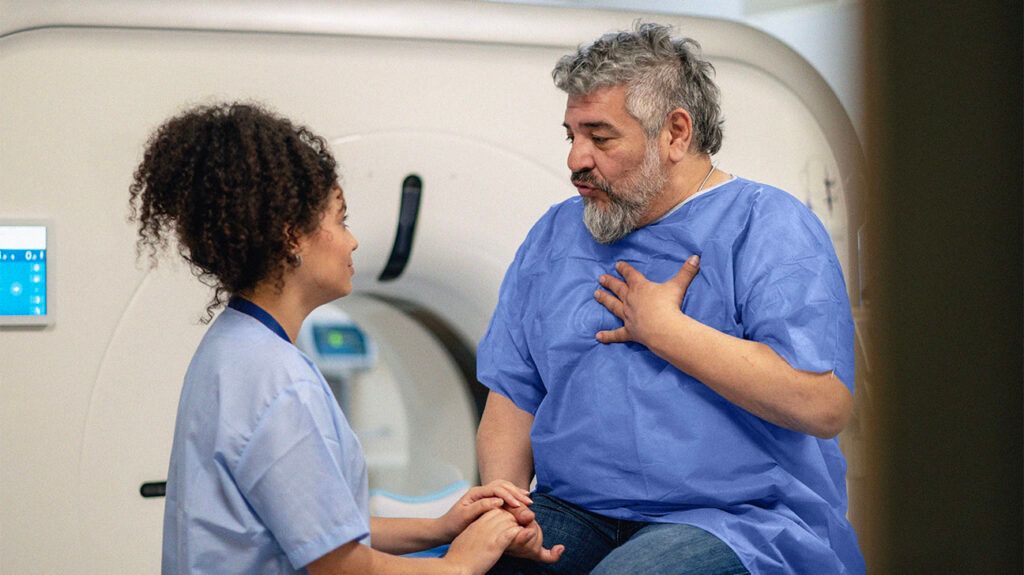Lung wedge resection is surgery that removes a small, wedge-shaped piece of lung tissue. It can treat early stage lung cancer or help doctors diagnose suspicious lumps or shadows on the lungs, visible in imaging scans.
Wedge resection may be effective in treating non-small cell lung cancer (NSCLC) and carcinoid tumors since they may be confined to one area of the lung. Doctors
Doctors may also use wedge resection to diagnose a lump or shadow on an imaging scan that may be lung cancer.

The lungs have several lobes. The right lung has three lobes, and the left has two. Each lobe has several segments. To treat early stage NSCLC, surgeons may remove a segment of the lungs in a surgery called a segmentectomy.
If a smaller area of the lung requires removal, surgeons perform a wedge resection. They often use video-assisted thoracic surgery (VATS), which is keyhole surgery using a camera. It uses smaller incisions than open lung surgery, requires a shorter hospital stay, and has fewer complications.
VATS wedge resection involves the following steps:
- A surgeon makes up to four small cuts, each about 5 centimeters long. The cuts allow the surgeon to insert instruments and a camera into the chest.
- The surgeon uses special staples to cut and seal the part of the lung that requires removal.
- The surgeon removes the piece of lung through one of the incisions.
- They close the wound with dissolvable stitches.
- The surgeon may insert one or two drains in the chest to extract fluid or air from around the lung.
Surgeons may have to switch to open surgery if they cannot access the affected area of the lung. This is called thoracotomy, which involves the following steps:
- The surgeon makes one long incision under the shoulder blade between two ribs.
- They part the ribs to access the chest and may need to cut a rib to improve access.
- The surgeon follows the same technique for removing the affected area of the lung.
- They use strong stitches to put the ribs, muscles, and skin back together.
Read more about lung cancer surgery.
People with early stage NSCLC may be able to have wedge resection surgery if doctors consider them healthy enough. They may perform the following tests to check whether someone is a good candidate for surgery:
- pulmonary function tests to make sure there would be enough healthy lung tissue remaining after surgery
- an electrocardiogram (ECG or EKG) to check the heart’s electrical activity
- an echocardiogram to check the heart’s function
- blood tests or other studies
People with advanced lung cancer or cancer that has spread to the lungs are usually not suitable for surgery.
The following sections describe how to prepare for surgery and what to expect from surgery and recovery.
Preparing for wedge resection surgery
In the months before surgery, a person should quit smoking if necessary, eat a nutritious diet, and ensure they understand their insurance coverage.
A doctor will provide instructions for what to eat or drink during the 24 hours before surgery. They will also discuss the medications a person should take or stop taking. The person should arrange for transportation to and from the hospital.
During wedge resection surgery
Before surgery, an anesthesiologist will administer general anesthesia. This is usually done intravenously, through a thin tube inserted into a vein in the arm or hand. The anesthesiologist will remain in the operating room and monitor the person continuously.
After surgery, the care team moves a person to a recovery room and then to their hospital room. They may feel groggy when they wake up and will receive medications to help with pain. Any chest drains are usually left in place for a few days, but some people may need to go home with them still in place.
Recovery after wedge resection surgery
During recovery in the hospital, a respiratory therapist may recommend breathing treatments, such as a spirometer or medications to help improve lung function.
Most people can go home 1 to 4 days after surgery. Before going home, the care team will give recovery instructions, including how to change bandages and what kind of physical activity a person can do.
A person will need follow-up appointments that may include physical therapy or pulmonary rehabilitation.
At home, a person must follow their doctor’s recovery advice. They may experience shortness of breath that improves over time.
If a person feels pain or discomfort that stops them from taking a deep breath, coughing, or moving, or if they are having difficulty coping, they must talk with their doctor.
Recovery can take weeks or months, depending on a person’s general fitness and the method of wedge resection. It is not unusual for an incision to be sore 6 months after surgery.
Some people may require additional treatments, such as chemotherapy or radiation, following surgery.
Wedge resection is a good option for people who may not be able to tolerate more extensive lung surgery, such as a lobectomy, which is the removal of an entire lobe. They may have reduced overall lung function or other health issues that might affect their recovery.
Removing only a small section of tissue and preserving more healthy tissue may help improve outcomes for these people. This may also benefit people who develop lung cancer a second time.
People diagnosed with NSCLC are at
Wedge resection is a major operation and carries various risks, including:
- adverse reactions to anesthesia
- excess bleeding
- blood clots
- infection
- pneumonia
- air leaking from the lung into the chest drain, which may last days or weeks
- temporary loss of kidney function, which tends to improve after taking in plenty of fluid
- shortness of breath, which may require a person to use a ventilator if it is severe
- a hole forming near the staples, which causes air to leak from the lung
It is uncommon to die as a result of wedge resection surgery. One month after surgery, generally 99 people out of 100 are still alive.
Wedge resection is controversial. Some doctors believe it is
A 2023 analysis reported that people who had wedge resection surgery had a lower 5-year survival rate than people who had a lobectomy.
In contrast, a 2023 study involving 697 people with NSCLC found similar success rates for wedge resection and lobectomy. The 5-year survival rate for both procedures was around 80%.
Most experts believe that lobectomy should be the first option for people with early stage lung cancer, unless a person is unable to tolerate it.
Wedge resection involves removing a small section of a lung to remove cancer or diagnose an issue spotted on an imaging scan. Doctors usually use keyhole surgery, which carries fewer complications and a quicker healing time.
This procedure is helpful for people who may not be able to have more extensive lung surgery.


